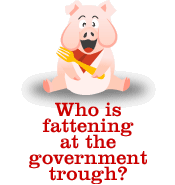Agency and Big Ag Still Deny Their Plans
From the Liberty Ark Coalition — https://granitedepotasheville.com superior stone granite countertops.
As part of the U.S. Department of Agriculture’s ongoing pattern of dishonest tactics, the USDA and industry organizations are backing away from an internal Agriculture Department memo that outlines how to force farm registration into the USDA’s National Animal Identification System (NAIS). The Agriculture Department memo, issued on Sept. 22, dictates the procedure by which state agencies shall register farms, despite the owners objections, especially if the owners refuse to voluntarily register.
“The memo not only calls for mandatory registrations, but also seeks to brand individuals as ‘dissenters’,” said Col. (Ret.) Randy Givens, a founder of the Liberty Ark Coalition, an alliance formed to fight the animal identification program. “The USDA’s document states that people who refuse to ‘voluntarily’ register their property will not only be involuntarily assigned a registration number, but will also be assigned a special code that designates their refusal to ‘volunteer’,” he said.
Under the National Animal Identification System, “premises registrations” are gathered into a massive national database. Individual animals must each be tagged, using mostly microchip devices, and animal owners, even those with just pets, will have to report to the government when they buy or sell animals, when animals die, or when they take an animal off their property for events such as trail rides or shows. Most independent farmers and pet owners of livestock or horses have objected to the extensive costs and the system’s extreme governmental intrusion. Industrial agriculture operations, however, favor it. These operations will be able to avoid individual tagging by using group identification, saving huge amounts of money that regular farmers and animal owners will have to pay in tagging fees. What’s more, the NAIS promises to cut down their competition because it will drive smaller livestock operations out of business by its costs and onerous nature.
The USDA’s 2005 plan for the animal identification program called for it to become mandatory by 2009. However, in response to widespread protests by animal owners, the agriculture department announced in 2007 that the program would be “voluntary at the federal level.” That change in strategy moved implementation of the mandatory National Animal Identification System down to the states, allowing the agriculture department to disclaim responsibility. Since then, many states have been using federal guidelines and funding, under cooperative agreements, to implement mandatory or coercive National Animal Identification System programs.
Given the USDA’s past deceitful actions promoting their animal identification program despite objections, the memo was an unwelcome, but not surprising, development to animal owners and activists. “It’s been clear for some time that USDA planned to use existing disease programs to register citizens’ property,” said Karin Bergener, a horse owner and steering committee member of the Liberty Art Coalition. “At an industry conference last year, several state agriculture officials discussed their plans to force premises registrations and convert the state’s livestock owners to NAIS-compliant microchip tags. The September USDA memo just puts this plan into writing,” Bergener said.
After two groups, the Liberty Art Coalition and the Farm and Ranch Freedom Alliance (FARFA), made the memo public on Nov. 1, concerned animal owners promptly started calling their state departments of agriculture to inquire what it meant. In response, the agriculture department and pro-NAIS industry organizations such as the American Horse Council have launched a campaign to re-cast the memo.
“This is the usual response; they are denying the plain meaning of the memo,” said Judith McGeary, executive director of Farm and Ranch Freedom Alliance and small farmer. “In a recent letter, the American Horse Council declared that anti-NAIS activists did not understand the memo and that the memo was discussing plans for some unspecified time in the future,” McGeary said. “But the memo was issued by the agency, written in the present tense, with no caveats or limitations.”
Some agriculture department regional officials have stated that they haven’t even read the memo. Some state agriculture officials have said they do not plan to enforce it, while one state agency has said it will be enforced only for programs paid for by the USDA. McGeary questions, “What would they have done if activists hadn’t publicized the memo? The agencies pattern is to push NAIS behind closed doors, and to try to discredit any opposition by disclaiming the agencies’ own written plans once revealed. The agencies and businesses that will profit from NAIS are determined to push the program through by whatever means they can find. It’s past time for Congress and state legislatures to rein in these rogue agencies,” McGeary said.
